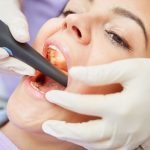
With the changing needs of patients, simply repairing and restoring teeth is not enough. Patients have aesthetic goals and aspirations that they expect their dentist Richmond to cater to. For the most part, clinics have been eager to expand, re-train and develop their cosmetic skills.
One of the procedures that have become more common is gum contouring. This article looks into how it can be performed and what it can achieve.
Why gum contouring?
Gums are a major aspect of a person’s appearance. They are the frames that the teeth are seen through. Regular, well-spaced arches that contrast against white teeth are considered the most attractive, with clearly defined triangles of tissue between each tooth.
They also have a determined apparent length of the tooth to gum ratio, with excessive gums making teeth look shorter and receding gums making teeth appear unpleasantly long.
How is gum contouring done?
Gum contouring is achieved by strategically removing unnecessary tissue. Depending on the clinic, this can usually be done using a scalpel or a surgical laser system. Although similar overall results can be achieved, healing times seem to be lower as is the risk of infection with laser systems, which cauterizes incisions as they are being made.
If gum tissue needs to be added, this can be achieved with grafting; however, this is more complicated than your average contouring, which focuses on the removal of tissues rather than addition.
Procedures are usually carried out in a single season and focus on the gum tissue at the front of the mouth as this has the greatest aesthetic value.
Related Posts
Post-treatment after contouring the gum line
The extent of the treatment has the biggest impact on not only the discomfort during the procedure but also the recovery time; some patients may have significantly more gum tissue removed than others.
As a general rule of thumb, patients undergoing more substantial treatment will need larger quantities of pain relievers and numbing agents, nullifying any discomfort during the procedure.
Patients are recommended to use over-the-counter painkillers to manage post-operative discomfort. In most cases, prescription pain relief is not considered necessary. In the following days, great care should be taken when eating, and food choices should focus on soft, easily digestible foods that require little or no chewing.
Complications of contouring the gum line
As with any invasive surgery, there is a risk of infection; if swelling continues to get worse or reduces only to reoccur, you should immediately contact a medical professional, particularly if the swelling is accompanied by redness, soreness, or warmth.
Gum contouring is often performed along with other dental procedures, for instance, crowning and veneering. Occasionally, there are interactions between these conditions. The dental professional carrying out the procedure may give you additional instructions or aftercare routines to manage these risks.
In a minority of cases, gum tissue may grow back to its original size and shape before the procedure is completed. This is known as a relapse, and although fairly uncommon, it is something you should be aware of. It is less common when the procedure has been performed using a surgical laser, so if you know you are at high risk of gum resurgence, it might be wise to seek out a provider who uses surgical lasers.





